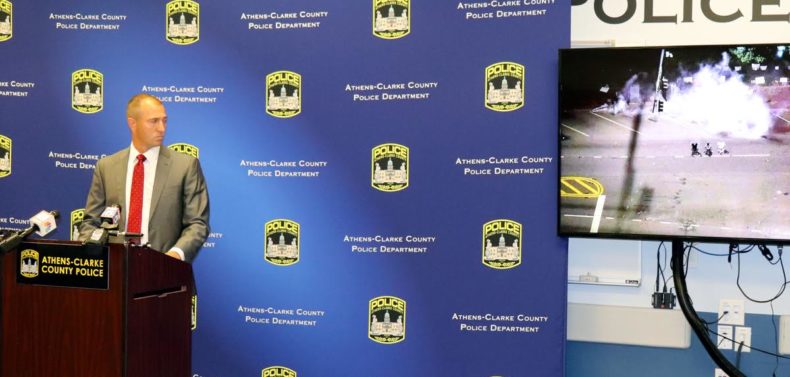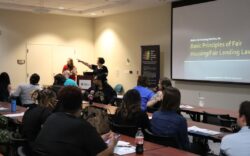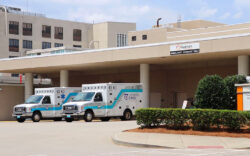The ACC Police Department has announced that an internal investigation found their use of tear gas and bean-bag rounds against protesters on the night of May 31 was reasonable and within department policy.
Lt. Harrison Daniel, commander of the ACCPD Office of Professional Standards, summarized the findings of their investigation in a press conference on Friday, July 31.
Before the demonstration began on May 31, ACCPD had already received intelligence from national and state law enforcement agencies that protesters were planning to loot and vandalize businesses and government buildings that day. They also heard that “extremist groups and agitators” would be present in the crowd. When self-identified members of the Boogaloo anti-government group showed up downtown armed with rifles, ACCPD considered the intelligence they received to be confirmed. This “elevated the threat assessment,” according to Daniel, making police uncomfortable and nervous.
As the planned portion of the protest came to a close, Daniel described how those remaining downtown were scrutinized by surveillance cameras and covert operatives for any small detail that could betray violent intentions. From that point, being dressed in colorful Hawaiian-style shirts or in all black, wearing long sleeves, entering a tent, carrying a backpack or wearing a larger than average mask were all interpreted by police as potentially threatening.
Police were also concerned by the fact that protesters seemed to be preparing to resist violence if it were used against them. As the night went on, protesters were bringing gallons of milk, heavy gloves, respirators and a leaf blower to the scene in preparation to minimize the damage caused by tear gas.
ACCPD originally claimed that “many” of the protesters occupying the area around the Confederate monument “appeared to belong to a violent extremist group.” Their story in this press conference was somewhat different—they now claim merely to have seen indications that “suggested the presence of extremists,” such as one protester out of roughly 200 wearing a Hawaiian shirt.
More troubling, they also overheard some protesters “agitating others to engage in violence and property damage.” However, other than spray paint on the Confederate monument, such vandalism did not occur on that night or during any of the many protests that happened in the months after.
As a final justification for assaulting protesters who had not engaged in any violent acts whatsoever, Daniel described the dismay police felt when protesters locked arms in formation, indicating their resolve to remain at College Square. “These actions significantly influenced the determination that chemical irritants [tear gas] were the most appropriate option to accomplish the goal of dispersing the unlawfully-assembled crowd,” Daniel said.
The goal of police was to clear the area, not make arrests. When people link arms, they can be difficult to remove without using force of some kind. In addition to passive resistance, police were concerned about extremist elements posing active, violent resistance if they were approached. In this situation, if not for tear gas, Daniel indicated that police may have had to resort to striking protesters with batons.
Making matters worse, Daniel admitted that ACCPD does not have an appropriately-trained and equipped “mobile field force” capable of responding to events of “civil unrest” like a protest. With the National Guard ready to go home by midnight, police felt that they had to act to clear the area efficiently while they had the extra help.
Weapons that police call “impact munitions,” also known as rubber bullets or bean-bag rounds, were used against protesters in addition to the tear gas. This was also within department policy, according to Daniel. These less lethal, although still potentially deadly, weapons were deployed only against individuals who tried to pick up, snuff out or kick tear gas canisters. Doing so effectively would have cleared the gas, allowing protesters to remain in the area. Therefore, those who disturbed the tear gas canisters were shot, in accordance with ACCPD policy. The decision to shoot was made by each officer at the scene individually and was not explicitly authorized by Police Chief Cleveland Spruill, who did authorize the use of tear gas.
Nineteen people were arrested that night, with the tents, milk and other items seized by police.
Originally, police had claimed that stacks of bricks were found inside the tents that could have been thrown at officers or used to smash windows. However, at this press conference, Daniel admitted that the tent “did not have anything significant in it of weight,” with video evidence showing one officer lifting it easily.
Daniel did discuss one failing of ACCPD’s handling of this event: not maintaining clear lines of communication with protest organizers after the planned events for the day ended.
Like what you just read? Support Flagpole by making a donation today. Every dollar you give helps fund our ongoing mission to provide Athens with quality, independent journalism.










